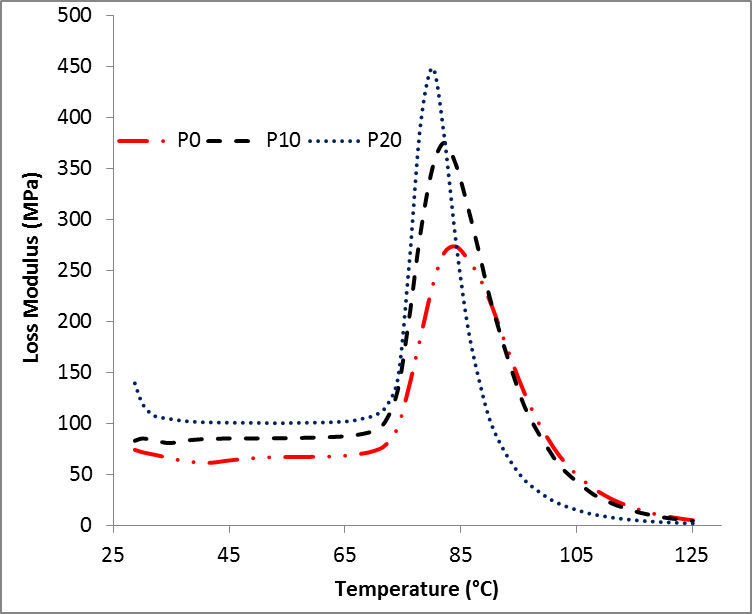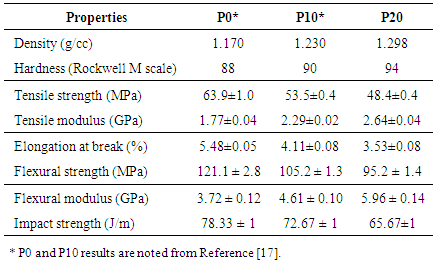-
Paper Information
- Next Paper
- Previous Paper
- Paper Submission
-
Journal Information
- About This Journal
- Editorial Board
- Current Issue
- Archive
- Author Guidelines
- Contact Us
Journal of Mechanical Engineering and Automation
p-ISSN: 2163-2405 e-ISSN: 2163-2413
2016; 6(5A): 18-21
doi:10.5923/c.jmea.201601.04

Thermomechanical Properties of Epoxy/PTW Composites
M. Sudheer
Department of Mechanical Engineering, St Joseph Engineering College, Mangaluru, Karnataka, India
Correspondence to: M. Sudheer, Department of Mechanical Engineering, St Joseph Engineering College, Mangaluru, Karnataka, India.
| Email: |  |
Copyright © 2016 Scientific & Academic Publishing. All Rights Reserved.
This work is licensed under the Creative Commons Attribution International License (CC BY).
http://creativecommons.org/licenses/by/4.0/

In this study, composites were prepared by reinforcing thermoset epoxy with different weight percentage (0, 10 and 20 wt%) of ceramic filler (Potassium Titanate Whisker, PTW) using casting method. The basic mechanical properties of test samples were evaluated as per ASTM standards and it was observed that except the strength all properties were found to improve with the PTW addition. The thermomechanical properties of the samples were investigated by Dynamic Mechanical Analysis (DMA) over a temperature range of 25°C to 125°C. Storage modulus and loss modulus of the Epoxy/PTW composite samples exhibited considerable improvement over the initial temperature range. However, damping (tan δ) peaks of composites were lowered by addition of PTW filler. The study indicated that incorporation of PTW in Epoxy could effectively improve the thermomechanical properties of composites.
Keywords: Ceramic whisker, DMA analysis, Epoxy, PTW
Cite this paper: M. Sudheer, Thermomechanical Properties of Epoxy/PTW Composites, Journal of Mechanical Engineering and Automation, Vol. 6 No. 5A, 2016, pp. 18-21. doi: 10.5923/c.jmea.201601.04.
Article Outline
1. Introduction
- Epoxy composites are extensively used in a variety of applications from aerospace to automobiles to sports utensils which demand materials with good mechanical, thermal and electrical properties [1]. Recently different ceramic whiskers such as Silicon Carbide (SiC), Alumina (Al2O3), Calcium Carbonate (CaCO3), Potassium Titanate Whiskers (PTW, K2O.6TiO2) etc. are used as reinforcements in polymers to improve its mechanical and thermal properties. Among the different ceramic whiskers, PTW is found to be a promising reinforcement for polymers in recent years. Being known as an advanced ceramic, the potential of PTW as filler in polymers for different types of applications is currently explored by many researchers [2]. Dynamic Mechanical Analysis (DMA) over a wide range of temperatures and frequencies permits the determination of the viscoelastic behavior of polymeric materials. The stiffness and damping characteristics of the composites can be analyzed using DMA which could be related to the morphology. The dynamic mechanical properties analysis is a convenient method for estimating the polymer transition temperatures that can influence the fatigue and impact properties of the composite [3]. The use of different polymer-filler combination to tailor and augment the dynamic mechanical performance of polymer composites has been the focus of many studies in recent years [4-15]. However, the DMA results in case of Epoxy/PTW combination is currently not available. The present paper reports the dynamic mechanical properties of Epoxy/PTW composites as a function of whisker content.
2. Experimental Details
2.1. Materials
- Potassium Titanate Whiskers (PTW) with diameter 0.5-2.5µm and length 10-100µm were purchased from Hangzhou Dayangchem Co. Ltd., Hong Kong. The morphology of these whiskers are presented in Figure 1. Room temperature curing epoxy resin (LY556) belonging to the diglycidyl ether of bisphenol A (DGEBA) family along with the amino based hardener (HY951) supplied by Huntsman Advanced Materials India Pvt., Ltd., Bengaluru, India was used as the matrix material.
 | Figure 1. SEM picture of PTW fillers |
2.2. Sample Preparation
- Composites are prepared with the varying percentage of PTW fillers (0, 10 and 20 wt%) using casting procedure. The procedural steps in the casting process are presented elsewhere [16]. Test samples are coded as P0, P10 and P20 where numerals indicate the percentage of PTW in composite.
2.3. Static and Dynamic Mechanical Analysis
- The basic mechanical properties of P0 and P10 samples are referred from earlier publication. The mechanical properties of P20 are new information and carried out as per ASTM standards explained elsewhere [17]. Dynamic mechanical thermal analyzer, Q800 from TA Instruments was used for the evaluation of dynamic mechanical properties. DMA test were performed in a single cantilever mode at a fixed frequency of 1 Hz. Experiments were carried out in a temperature range from room temperature to 125°C with a heating rate of 3°C/min. The DMA results are expressed in terms of the storage modulus (E′), loss modulus (E′′) and damping factor (tan δ) which are dependent on the temperature, time and frequency.
3. Results and Discussion
3.1. Basic Mechanical Properties
- The static mechanical properties are presented in Table 1. The addition of PTW has improved the density, hardness and moduli under tensile and flexural loading conditions. However strengths under tensile, flexural and impact loadings found to decrease with PTW content. The detailed discussion on the effect of PTW on epoxy is presented in earlier publication [17] which holds true in case of P20 test sample and is not discussed here.
|
3.2. Storage Modulus (E′)
- Figure 2 shows the storage modulus (E′) of neat Epoxy and Epoxy/PTW composites as a function of temperature. The E′ values of all test specimens decreased with increasing temperature because of the increased mobility of epoxy polymer. Meanwhile, the drop in E′ values was steep near the glass transition temperature (Tg) of epoxy (80–100°C). This dropping trend in modulus is typical of the viscoelastic behaviour of polymer in general [3, 4]. The incorporation of the PTW is found to obviously increase the storage modulus. Within the experimental initial temperature range (up to 80°C), the storage modulus of the Epoxy/PTW composites is higher than that of neat epoxy. For instance, at 65°C, the storage modulus of P0, P10 and P20 samples are found to be 2305, 3015 and 3562 MPa, respectively. The percentage improvement in the storage modulus of two composite at 65°C compared to P0 sample is 31% and 54% respectively. This considerable improvement may be due to two reasons. First, the applied stresses are expected to be easily transferred from the matrix onto PTW whiskers due to the high surface area of whiskers. Second, for the given temperature and applied stress conditions, the strong bonding between the polymer and whiskers were able to restrain the mobility of local matrix around the whiskers.
 | Figure 2. Storage modulus as a function of temperature |
3.3. Loss Modulus (E′′)
- Figure 3 shows the loss modulus of the neat Epoxy and Epoxy/PTW composites as a function of temperature. The same change trend in the loss modulus is observed in the test samples with respect to change in the temperature. As can be seen from the Figure 3, there is a gradual increase in loss modulus till the curve reaches a peak, after which there is a steep decline in the loss modulus values. The P20 sample showed higher modulus values till curve peak and it showed comparatively lower values thereafter. Thus the effect of whisker loading on the loss modulus is different before and after the curve peaks.
 | Figure 3. Loss modulus as a function of temperature |
3.4. Damping Factor (Tan δ)
- The dissipation of energy in a material under cyclic load is known as damping. The damping factor or tangent of the phase angle, tan δ can be used to measure the potential of a material to dissipate and absorb energy. The damping properties of the material give the balance between the elastic phase and viscous phase in a polymeric structure [4]. The damping factor tan δ is also defined as the ratio of the loss modulus to the storage modulus (E''/E'), which is very sensitive to solid structural transformation in materials. Figure 4 shows the temperature dependence of tan δ for the neat Epoxy and Epoxy/PTW composites. The change trend in the tan δ curve is quite similar for all test samples.
 | Figure 4. Damping factor (tanδ) as a function of temperature |
4. Conclusions
- The effect of elevated temperature on the Epoxy and Epoxy/PTW composites was measured using DMA analysis. The maximum storage and loss moduli were recorded for Epoxy/PTW composites. The damping factor value recorded was also maximum for Epoxy/PTW composites. The PTW addition to Epoxy has shown positive effect on the dynamic mechanical analysis. However, glass transition temperature (Tg) values were found to decline with the PTW addition. The basic mechanical properties of composites such as density, hardness, tensile modulus and bending modulus found to improve with PTW addition whereas strength values found to decrease.The study revealed that PTW can be a potential filler to improve the static and dynamic mechanical performance of epoxy polymers.
 Abstract
Abstract Reference
Reference Full-Text PDF
Full-Text PDF Full-text HTML
Full-text HTML